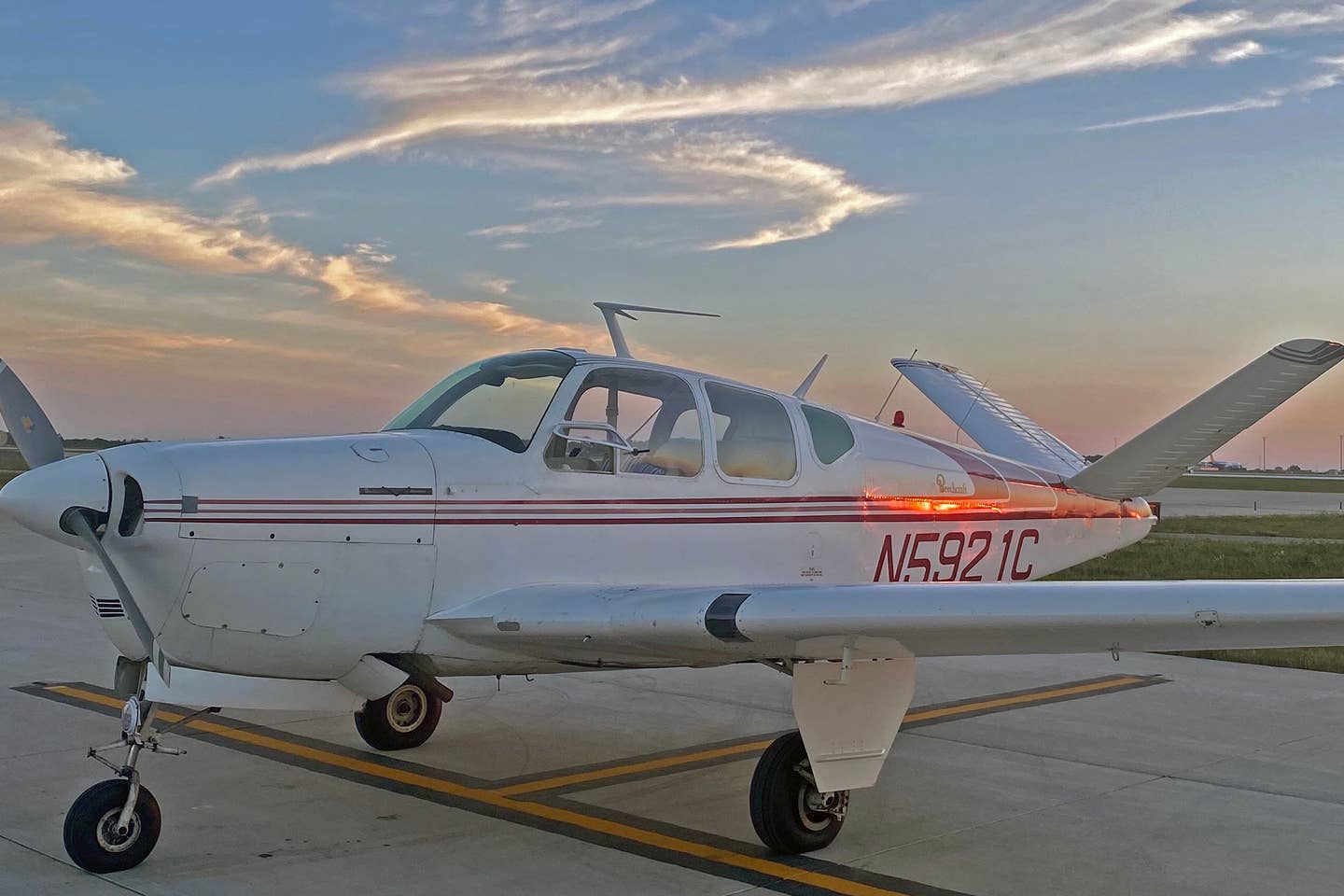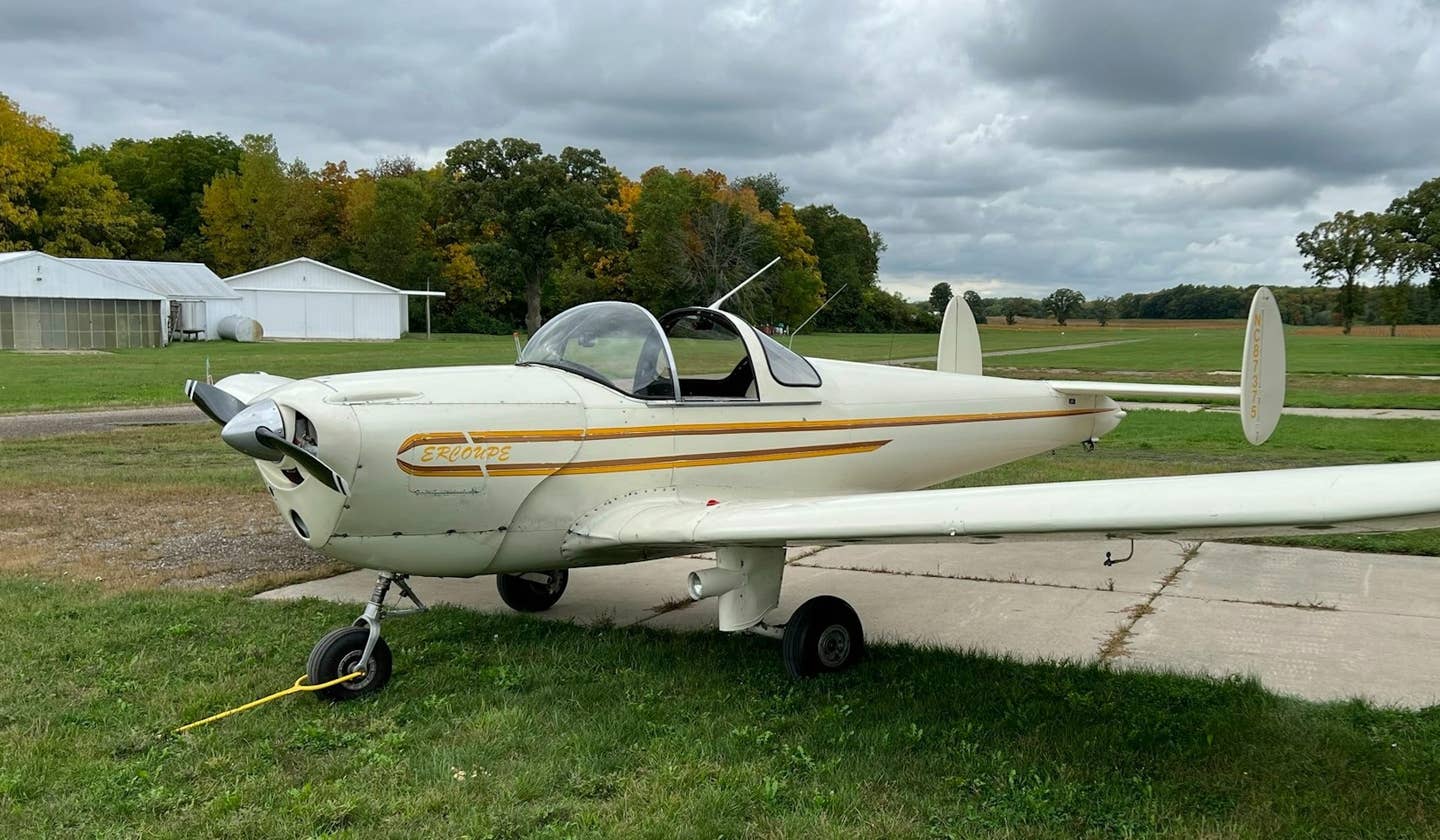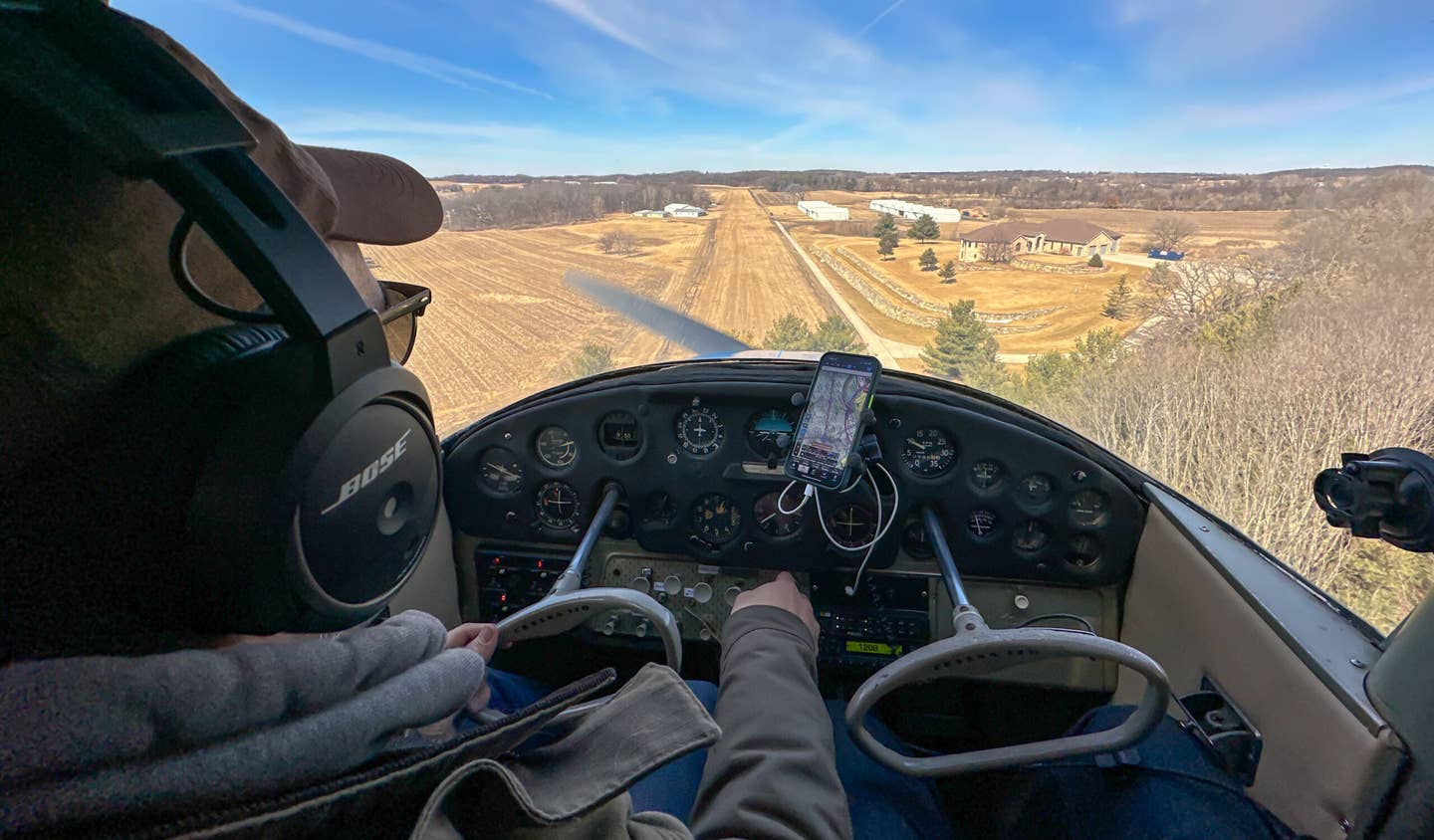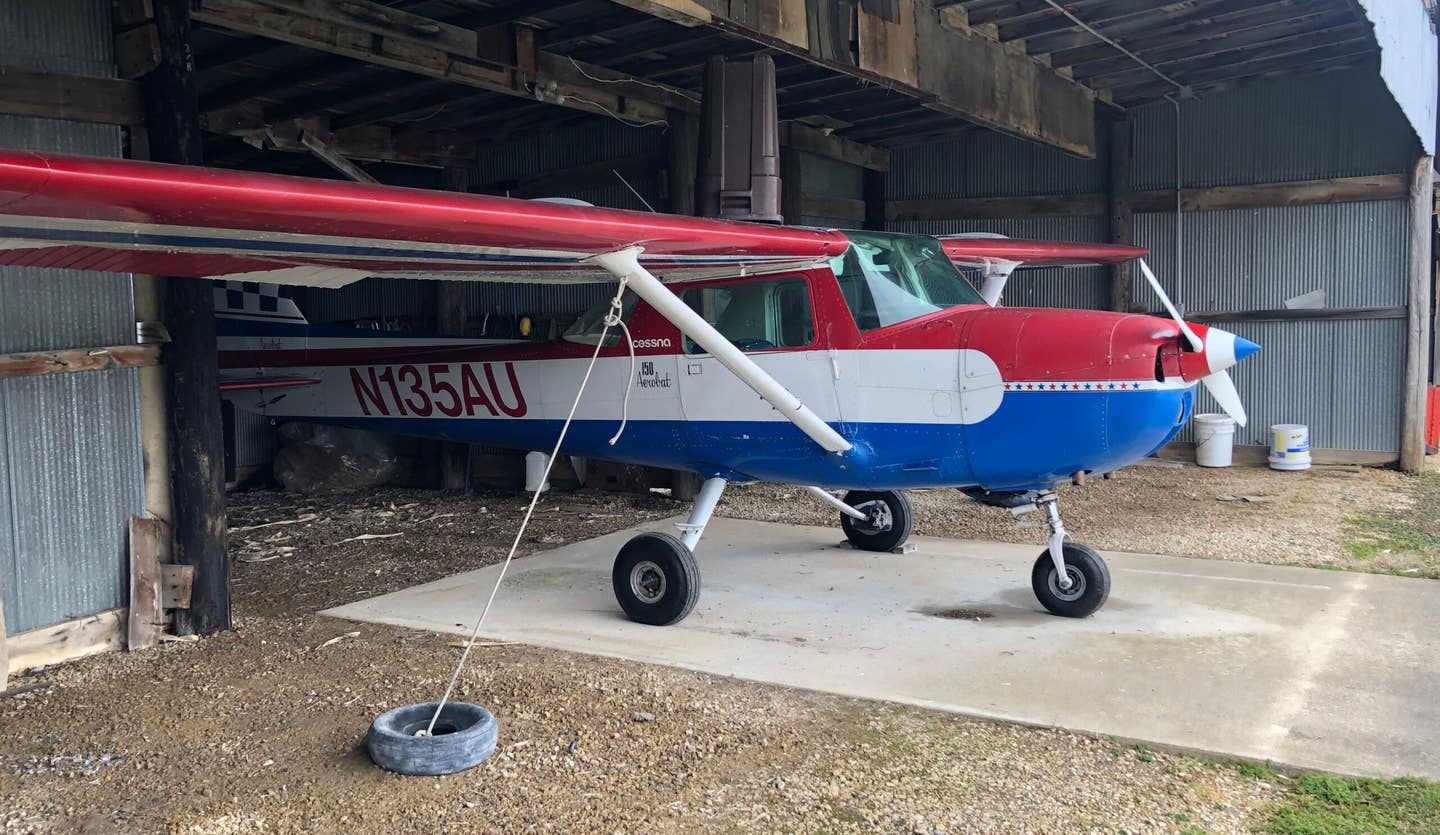
Stevie Triesenberg’s Beechcraft Bonanza. Courtesy: Stevie Triesenberg
Years ago, when I moved from Michigan to Wisconsin, I left behind the greatest flying club I’ve ever known.
It had the most extensive fleet of any in the region. Seven airplanes were available, ranging from Cessna 152s to 182s and topped off with a Beechcraft Debonair, a less-expensive version of the legendary Beechcraft Bonanza. As a newly-minted 19-year old private pilot and club member, it felt odd to be part owner of seven airplanes, yet not permitted to rent a Ford Aspire worth $9,000.
Oh, That Beechcraft
I was smitten by that Beechcraft. The undisputed queen of the fleet, N8999M was leagues above any of the typical Cessnas or Pipers on the field. Compared with other types that made you feel like you’re sitting on the floor, it placed you in a commanding, stately position. The beefy yoke and pedals felt as though they were all machined out of solid blocks of aluminum, and they rolled through their travel so smoothly, you couldn’t help but envision the perfectly lubricated bearings guiding them along.
That airplane made an impression on me, and I flew it as often as I could.
I wasn’t the only one enchanted by the feel of that airplane. A couple of years ago, I crossed paths with a current member of that club who fell even more deeply into love with it. So deeply, it turns out, that when she decided to purchase her first airplane, she skipped right over the usual, more basic types and bought her very own Bonanza.
Choosing a high-performance, complex, vintage Bonanza as one’s first airplane is certainly unconventional, and the general aviation community seems split on the matter. One camp thinks that ownership should begin with a less-expensive type that’s easy to fly and maintain; a stepping stone toward one’s longer-term, dream airplane. The other camp firmly believes a buyer should buy his or her last airplane first, reasoning that wading through transitory types is an unnecessarily expensive and lengthy process.
This was the camp to which Stevie Triesenberg belonged.
Putting in The Leg Work
For her, the combination of speed, character, and vintage style was irresistible. Despite having only logged about 500 hours, she had been working as a CFI for long enough to have experienced most of the typical Cessnas and Pipers. While she enjoyed and respected those types, the impression left by the classy Beechcraft was simply too intoxicating to ignore. It didn’t take long before she began a five-month process of learning as much as possible about Bonanzas and finding the perfect example to purchase.
Having helped the flying club shop for 172s, Stevie had learned that nice examples routinely sell for around $80,000 - so when she discovered that early, basic Bonanzas can be had for as little as $40,000-$60,000, she was intrigued. Complex, high-performance aircraft are obviously more expensive to fly and maintain, and 70-year-old airplanes come with their own costly concerns, but when those expenses can be partially offset by a lower acquisition price, the equation begins to make more sense.
Her obsession became bolstered by motivation, and she dove into all the resources she could find, soaking up as much information as possible. She joined all the Bonanza clubs and online forums, posting questions of her own and sifting through those submitted by others. Her constant monitoring of the classifieds revealed multiple Bonanzas with potential, but one after another, they either proved to be mechanically unsound or had been purchased literally minutes before her inquiries.
Eventually, she encountered N5921C—a 1952 C35 Bonanza that, while dated, appeared to have been well-maintained and cared for. The paint was tasteful and in decent shape. The panel was decidedly low-tech with instrumentation as old as the airframe, but it was clean and uncluttered. Best of all, it still sported the classy, 1950s-era, chrome-plated “piano key” buttons.
Stevie wasted no time in scheduling a pre-purchase inspection, and was soon flying her new pride and joy around the Midwest. A year and a half later, she had logged 170 hours in it, flying to various places across the Midwest and also to Oshkosh for AirVenture 2021.
Paying the Price
During that year and a half, the airplane was down for maintenance a few times, primarily because of issues attributable to the airplane being an older model with some difficult-to-find parts. Her electrically-controlled propeller, for example, requires service every 250 hours, and during the most recent check, it needed a very hard-to-find replacement bearing. She spent quite a bit of time tracking one down and waiting for her phone calls to be returned before finally finding one...for $2,000. Her airplane was down for about two months as a result.
She was grounded for another month when two cylinders needed to be replaced. Once again, the age of the airplane was a hindrance, as cylinders for that particular engine are challenging to source. She spent time searching high and low, and eventually located what she believes were the last two factory-new cylinders in the country for a Continental E-225-8 engine.
Once again, her maintenance struggles proved to be more attributable to the relative age and rarity of the parts as opposed to the airplane being complex or high-performance.
Advice?
Looking back, what tips would she have for others interested in a high-performance or complex single as their first airplane?
Become a sponge. After determining which type you’re most interested in, seek out the various Facebook groups, online forums, and owner’s groups associated with that type. Ask questions and browse through the questions others have asked in the archives. It’s possible to learn every lesson yourself, but it’s cheaper and easier to learn from the lessons of others.
Always invest in a very thorough pre-purchase inspection by a mechanic familiar with the type. This is doubly important with regard to a complex type, as there will naturally be more things to inspect. More things to inspect also means more potential deal-breakers - issues that, if uncovered, may render the airplane not worth pursuing.
Spend extra time and diligence going through the aircraft and engine logbooks. On the surface, a missing logbook with five years of maintenance unaccounted for might seem like nothing more than a nuisance. But one of those pages might contain proof that a costly airworthiness directive has been complied with, and having to address that after the fact could necessitate another large expenditure to keep the airplane legal.
Be patient. The purchasing process can be drawn out, and won’t happen instantaneously...nor do you want it to. Between the pre-purchase inspection, the test flight, the escrow process, and the other steps involved, thoroughness pays off...and thoroughness takes time.
Determine the “worst case” in terms of ongoing maintenance expenses, and plan for that number. This doesn’t mean we have to anticipate an engine replacement every year. But it does mean that it would be wise to survey owners, determine the upper end of their typical annual inspections, and budget for that number.
Exercise discipline and respect the airplane. This is one of the most critical aspects of choosing a more advanced type as a first airplane, and the mentality that the airplane’s capability can substitute a pilot’s lack of experience is a dangerous one, indeed.
Despite being an instrument-rated flight instructor herself, Stevie seeked out specialized instruction from another CFI with extensive Bonanza experience. They worked through many drills specifically tailored to the type, including the emergency gear extension process and steep spiral recovery. Before long, her nervousness was replaced with confidence, and she now greatly enjoys flying the airplane.
Get involved in the community of type owners. Participate in their dedicated online forums, attend club fly-ins, and meet up with a member or two once in a while to swap morsels of wisdom over breakfast. In addition to learning more about the complexities of your airplane, this kind of networking also helps the group to identify and address emerging maintenance concerns that arise from any aging airframe before they become a hazard.
Stevie’s ownership experience has thus far proven to be an enjoyable one. Yes, she has encountered challenges along the way, but with properly-calibrated expectations, good preparation, a healthy dose of discipline, and a willingness to learn, she has managed to make her Bonanza a great first airplane.
Jason McDowell is a private pilot and Cessna 170 owner based in Madison, Wisconsin. He enjoys researching obscure aviation history and serves as a judge for the National Intercollegiate Flying Association. He can be found on Instagram as @cessnateur. You can email Jason at editorial@flying.media with any questions or comments you have.

Sign-up for newsletters & special offers!
Get the latest FLYING stories & special offers delivered directly to your inbox






